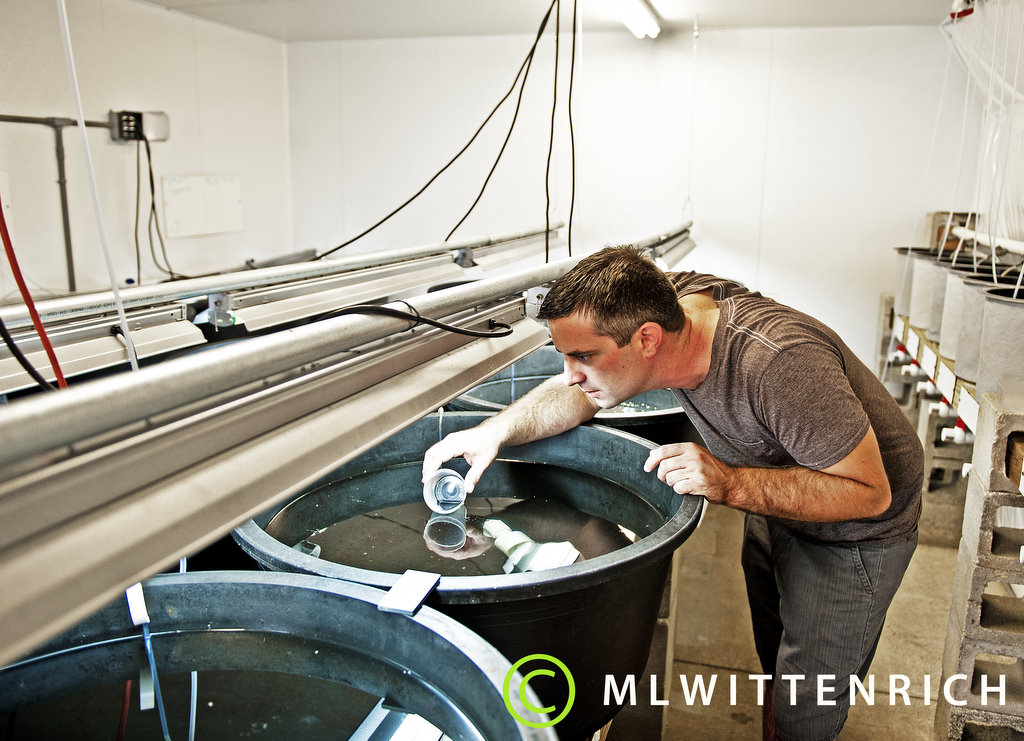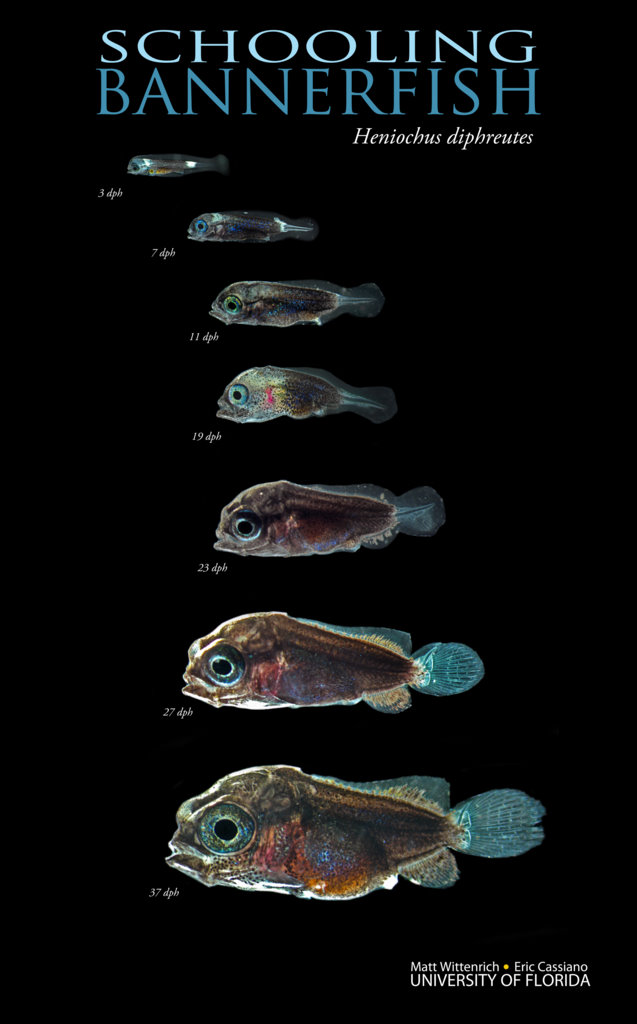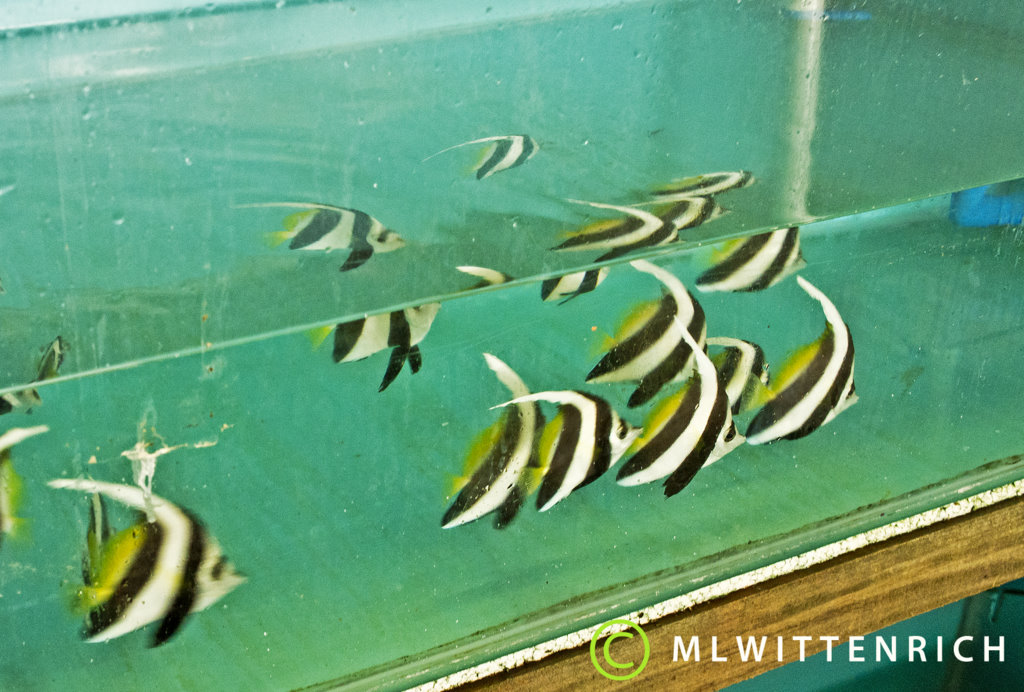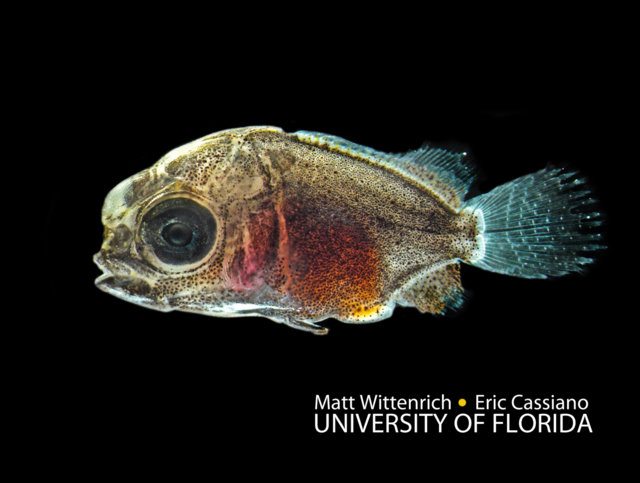Eric Cassiano releasing eggs and larvae from the Columbus Zoo and Aquarium into the rearing tank after acclimation.
Forty one days ago, after receiving a shipment of eggs from Paul Rinehart and Ramon Villaverde of the Columbus Zoo and Aquarium, we had no idea what we were about to accomplish…or almost accomplish. In Columbus Ohio, Paul and Ramon gathered the nightly spawn from the floating egg collector and took great care separating good eggs from bad ones. This was a good spawn. They collected about 9 mL of eggs, about 300,000 eggs. They transferred the good eggs into fresh clean seawater after charging it with pure oxygen. The bags were then closed up with no air space to avoid unnecessary splashing as the box was shipped since we thought this could potentially damage the delicate eggs and larvae. The styrofoam box was packed up and shipped FedEx priority overnight.
At the University of Florida’s Tropical Aquaculture Laboratory we prepared four larval rearing tanks in preparation for the Columbus shipment. Since most of the eggs and larvae coming from public zoos and aquariums contain species that have not been raised before we are charting into the unknown. The Rising Tide Conservation Initiative is specifically looking at tangs and angelfish and other small egg pelagic spawning species since these are the most widespread in captive aquariums and the ones we know comparatively little about. Protocols for rearing these types of larvae just aren’t available. How much light do we put on the tank, do we add greenwater, what type, how much, what do we feed them, do they exhibit a fright response when plankton densities are too high? These are all questions that are commonly taken for granted when rearing a wide range of species, but unfortunately for us, they have no answers. Our biggest goal in larval rearing is to establish a rearing environment that contains a variety of conditions so the larvae can find an area of the tank that will elicit a feeding response and hopefully survive.

Dr. Wittenrich inspecting and feeding Heniochus diphreutes larvae at the Tropical Aquaculture Laboratory.
We stocked two bags, each containing about 2.5 mL of eggs, into two 50 gallon black round tanks. The other bag was divided equally among three 20 gallon black round tanks. The day after receiving the eggs all was going according to plan. We had a decent hatch rate and could see the early larvae hanging in the water column, darting every so often to replenish the oxygen rich boundary layer of water surrounding their bodies. The larvae did not have eyes or mouth. It would be another two days before the yolk would be depleted and the mouth and eyes would be functional.
When the larvae were ready to feed three days post hatch we marveled over the tanks. The majority of larvae had transformed from seemingly lack lust prolarvae to remarkably pigmented larvae with bright white spots on the head and tail separated by a thick black patch. We could see a few orange shoulder tang (Acanthurus olivaceus) larvae in the mix, but this shipment was dominated by a new unknown larvae that we had not seen before. We added about 2 liters of live phytoplankton (T-ISO) to the tanks and added a very slight dribble of bubbles from an open ended air line. We were excited to see something new, but had no idea what the larvae were and if they would feed.
In our larval rearing room at the Tropical Aquaculture Lab we try to maintain a protocol for handling the unknowns. We don’t just want to see if we can raise something, we want to see how we were successful at raising a species, what they ate and what they did not, along with the environmental conditions that contributed to a successful feeding reaction. To do this, we feed size sorted wild plankton. A wealth of information is available today that was not available 10 years ago. Studies on the gut contents of wild larvae from Australia and South Florida have shown remarkable selectively of marine fish larvae. This selectivity is often marked at the family level and varies wildly. According to Llopiz and Cowen (2008) marine fish larvae have likely evolved into trophic feeding niches within the plankton environment. Sampey et al. (2007) marine fish larvae feed on very unique organisms in the plankton from cyclopoid copepods to appendicularians and cheatognaths. Our own research has shown that most of the fishes commonly raised for the marine ornamental trade are generalist feeders (Wittenrich 2011 dissertation). Such generalist feeders, clownfish and dottybacks to name a few, will consume most any type of zooplankton they encounter. Others, such as damsels select cyclopoid copepods and tangs….well, we just don’t know yet. What a species chooses to eat goes a long way in identifying a commercial protocol of production. Our approach stems from a proven formula of identifying what a species eats through ontogeny and then culturing the organism to form a captive food chain.
All of the food in the world doesn’t help though if the environmental conditions are not right. We have shown time and time again that the rearing tank plays a vital role in eliciting a feeding reaction. Many times the appropriate food is available, but the larvae fail to feed. When we change certain aspects of the rearing environment like the amount of light or the current we often notice stark differences in feeding reactions. This is where our gradients come in.

Larval cycle of Heniochus diphreutes raised at the Tropical Aquaculture Laboratory.
If we were to set up a 10 gallon tank with an air stone and a fluorescent light above it, everything about the environment would be pretty much homogenous. Either we set up an environment that is conducive to elicit a feeding reaction or we have not. Most of the time, we have not and the larvae die. To add to this confusion as the larvae develop their requirements for certain environmental conditions change.
Our rearing tanks are connected to central filtration systems. Within these tanks we create gradients of current. There is a fast flow on the perimeter of the tank that slows as it nears the center. We use double fluorescent bulbs in the center of the tank that provides strong illumination in the center of the tank that fades as it reaches the perimeter. These gradients of light and current sometimes offer picky feeders appropriate conditions to feed.
We were amazed by the feeding reaction exhibited by these new unknown larvae. A cursory glance from above revealed striking larvae throughout the rearing tank. Two hours after we added zooplankton to the larval rearing tanks we sampled a half dozen larvae and examined them under the microscope to see what they had eaten. Incidence of feeding is generally low in early larvae, but these ones were voracious. All of the sampled larvae had prey in their guts. Not just one or two prey items, but up to 13 copepod nauplii were consumed. Now we were excited. We preserved the tiny larvae and their copepod prey and are currently in the midst of the identifying and culturing them.
For the first 11 days we knew we had something different, but still had no idea what the larvae were. We sent a few out to Dr. Tom Waltzek for identification, but hadn’t gotten the results back. They continued eating and growing and we continued to guess as to what they could be. We had a list of species in the Discovery Reef Exhibit and some days we swore they were golden trevally, then soldierfish. In the end we had no idea. We had two tanks with good numbers of larvae and continued the daily routine of adding live phytoplankton, feeding copepods, cleaning filter socks.
The first bottleneck in development came 15 days after hatching. The larvae were actively feeding, but their numbers kept dwindling. We suspect that some of these losses could have been water quality. We plumbed in a fluidized bed sand filter to act as the powerhouse of biological filtration, but it was not totally matured by the time these larvae were stocked. We performed weekly water changes to keep up with water quality, but did have ammonia spikes to about 0.25 mg/l.
By day 20 the larvae started changing their appearance. Their heads started getting big and their bodies slender. After observing a few under a microscope we could see they had developed plates on their head. The most obvious was a large, anterior projecting, spine from the base of the preopercle. Another one seemed to lift the eyes a bit and give them mini horns, and a third plate covered the top of the head behind the eyes. As they were developing these plates they were also undergoing flexion. The notochord starting tipping up and the hypural plate was seen forming on the ventral surface. Within days the hypural plates had formed and caudal rays were visible. The head seemed to get bigger with the developing plates.
This is when we started getting worried. With all of these developmental changes came behavioral changes. In the morning the larvae were active in the water column eating and striking with definite motivation. Then, a few hours later the larvae would be head down in the water column as if they were resting. Some would drift to the bottom and lay there, some would get tangled in bottom debris, and others would just spiral out of control as they hit the bottom. Our numbers were dwindling fast now. Day after day the larvae would go through this pattern of feeding and resting. By the end of most days we were convinced that they would all be dead the next morning. But, day after day they would be up in the water column feeding the next morning.
About day 23 we got a call from Tom Waltzek with the DNA results. He was able to amplify the DNA and cross reference the sequence of our mystery larva with the genbank database. So, what was our mystery fish that fed so well as an early larva, developed plates on its head and reached a bottleneck with its development? “Heniochus diphreutes” Tom said over the phone! We had to hear it a few times to sink in. “Schooling bannerfish!” he said again.
Suddenly, it was all making sense. Members of the Chaetodontidae family are the only group known to exhibit a tholichthys stage prior to settlement. The plates on their head, the armor that taxed their physiology was the only thing standing in our way of a settlement stage bannerfish.
Upon hearing this news we were tremendously excited at not only ‘almost’ raising a butterflyfish, but also at reassessing the goals of the Rising Tide Conservation Initiative. Suddenly, it didn’t sound so crazy. With the help of the Columbus Zoo and Aquarium we had shipped coral reef fish eggs from Ohio. We got them to hatch, got them to feed and got them to grow. What an amazing accomplishment.
By day 30 our efforts had been reduced to a single tank with 7 larvae. Not the grandiose finish we had in mind, but better than nothing and we were still learning. After learning of their identity we spent countless hours and long days observing these larvae, searching for a hint that might help us close the gap and observe settlement.

Bannerfish at a wholesaler in Singapore. Captive bred bannerfish have the potential to alleviate stress on wild populations and potentially replace sales of moorish idols that fare poorly in captivity.
Today, our last hope died 41 days after hatching. Although we were not successful in raising a schooling bannerfish past metamorphosis we are hopeful and excited to try it again. The gut contents of our preserved larvae are being analyzed and we will have cultures up and running for the next shipment of mystery larvae. We learned of some of the bottlenecks and have some ideas on how to address them. These butterflyfish larvae were remarkable in that the incidence of first feeding was high and the mortality schedule was delayed until development of the tholichthys plates. We are hopeful that modifications to the rearing tank and diet can bring butterflyfish to the industry. Stories like this are becoming more commonplace and with each attempt comes new insight and opportunity.

The last remaining Heniochus larva died 41 days after hatching. This specimen gives us hope that we were close to settlement. The medial fin rays and pelvic fins were developing and the body was deepening; a sign we had been waiting days to see.
